Welcome to The Nature Conservancy of Idaho's blog, your source for Idaho natural history, wildlife, conservation and outdoor recreation. The views represented here are those of the authors and do not necessarily reflect the official views of The Nature Conservancy.
Tuesday, October 31, 2006
Opinion: Proposition 2 Endangers Idaho's Way of Life
Nature Conservancy Holds Photo Contest
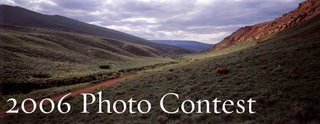
The Nature Conservancy is holding its first digital photography contest. Enter your photos that capture the diversity of life on Earth. Your own original digital images of our lands, waters, plants, animals and people in nature are all eligible for the competition. Images can be submitted to one of two categories: Best Nature Photo or Best Photo from a Conservancy Preserve.
Monday, October 23, 2006
Waterfowl hunting season underway at Silver Creek
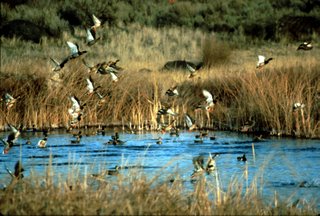 Fall waterfowl, photo by Guy Bonnivier
Fall waterfowl, photo by Guy BonnivierWaterfowl hunting is well underway at the Silver Creek Preserve and throughout Idaho. Waterfowl hunting is allowed at the preserve on Wednesdays, Saturdays and Sundays only and with limited hours until the end November (the end of fishing season). Hunting rules at the preserve are very specific, so be sure to thoroughly read through the rules posted at the visitor center prior to hunting. You can also visit with staff from 6-9 a.m. at the center on hunting days.
There are many different users of Silver Creek- birders, fishermen, school groups, canoers. Please follow the rules and respect other users!! Have fun and be safe!!!
Friday, October 20, 2006
Nature Conservancy Opposes Proposition 2
The Nature Conservancy is a strictly non-partisan group that works through voluntary agreements with landowners. We believe in conserving Idaho’s great places by using cooperation, free market solutions, and a business-like approach. And we respect property rights in all we do.
The Idaho Chapter’s decision is unprecedented. In our 30 years of work in this state, we have never taken a position on a ballot issue – until now. We step forward only due to the depth of our concerns about Proposition 2.
The backers of Proposition 2 claim that the measure is needed to ensure that eminent domain could never be used to take private property for private commercial development purposes – as was permitted in the U.S. Supreme Court’s controversial decision in Kelo v. City of New London. The truth is that the Idaho Legislature passed House Bill 555 last spring to restrict eminent domain for commercial development and effectively overturn the Kelo case in Idaho. Proposition 2 is not really about eminent domain.
The real damage of Proposition 2 would come from a separate section found deep in the text of the measure. This provision can be read to require taxpayers to compensate developers when new laws and ordinances prevent them from pursuing the densest subdivision development or “highest” use of their land. This sweeping financial entitlement has never been a feature of America’s law of property rights.
If Proposition 2 is approved, we question whether communities will be able to manage our state’s rapid growth or whether working farms and ranches—essential to our state’s economy—would be able to survive.
The only certainty we see in Proposition 2 is litigation, confusion, expense, and new burdens on the taxpayer. In the places we work, those are not good things for anyone.
The Nature Conservancy is a property owner in Idaho, at places such as Silver Creek, Cougar Bay, and Thousand Springs. Our neighborhoods include family farms and ranches, private timberlands, rural communities, and vital wildlife habitat. Wherever we work, we believe that one of our most important duties is to be a good neighbor.
We feel compelled to speak out because Proposition 2 is bad for our neighborhoods. If you care about our agricultural and forestry economies; hunting, fishing and outdoor recreation; healthy neighborhoods and private ranches, Proposition 2 threatens what you value.
Our choices today will shape our legacy for future generations. By voting “no” on Proposition 2, we can help to ensure a future that includes what we love most about Idaho.
Contact: Will Whelan at 208-350-2202
Tuesday, October 17, 2006
Redband Trout

The Nature Conservancy considers the Owyhees, the high desert country located in the southwest corner of the state, to be one of its highest conservation priorities in the state. This vast, five-million-acre county contains some of the best sagebrush habitat left in the country, and is also home to a long ranching tradition. The Conservancy has been a member of the Owyhee Initiative to create solutions to land use issues in the county, and also works on a number of on-the-ground conservation projects in the Owyhees.
The Owyhees are home to a variety of unique creatures, many of which live in the sagebrush habitat. But the rivers are also home to an interesting fish: the redband trout. This trout—a subspecies of rainbow trout—can be found in a number of rivers throughout the county.
High desert redband trout can survive at higher temperatures than any other trout species. This enables them to survive when desert temperatures soar in the summer. The trout face threats from introduced smallmouth bass in some rivers, and also from declining water quality.
On a recent visit to the Owyhees, my wife and I fished for this beautiful fish. In most rivers, you will not catch large fish, but you can catch many of them. Their colors are often quite vivid. The rugged canyon scenery is spectacular, and wildlife is abundant.

Although more people are visiting the Owyhees from rapidly growing Boise and the Treasure Valley, you can still find solitude and wild landscapes to explore. The Owyhee Initiative’s goal is to protect wilderness and wild and scenic rivers in the Owyhees so future generations can continue to experience the magic of the high desert.
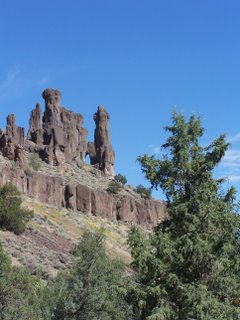
Wednesday, October 11, 2006
Malpais Borderlands Group
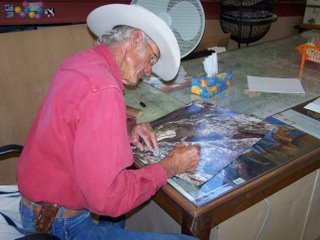 Rancher and conservationist Warner Glenn signs a poster of his latest jaguar photo, taken near his ranch in southern Arizona.
Rancher and conservationist Warner Glenn signs a poster of his latest jaguar photo, taken near his ranch in southern Arizona.Around the world, The Nature Conservancy works as a partner with rural communities, farmers and ranchers. Conservation easements remain a powerful tool for protecting rural economies and wildlife habitat.
The Idaho Chapter works with ranchers on many projects, including in the Owyhee Canyonlands, Henry’s Lake, Silver Creek, the Pahsimeroi River Valley and the Kootenai Valley.
On a recent trip to southern Arizona, I had the opportunity to visit another successful Conservancy partnership with ranchers. The Malpais Borderlands Group of Arizona is a grassroots group of ranchers who have created a non-profit organization to demonstrate that ranching and conservation can thrive together. Their work includes conservation easements, fire management, endangered species conservation and an active research program.
Their seminars showcasing their conservation-minded ranching have drawn people from all over the world—including Masai herders from Kenya, Mongolian park managers and U.S. livestock ranchers—to their ranches along the Mexican border. The project also published a recent book, Working Wilderness.
Ranchers Warner and Wendy Glenn, who own the Malpais Ranch, hosted Nature Conservancy staff on their ranch during my trip. Warner is well known not only as a rancher and conservationist, but also as one of the best lion hunting guides in the West. In 1996, his hounds located a jaguar in southern New Mexico, near the project. Glenn photographed this beautiful animal and wrote a booklet on it, using this to showcase the importance of conservation in this region.
This year, he once again saw a jaguar in New Mexico. He is the only person to have seen a jaguar in the United States in the past decade. Glenn speaks of the thrill of seeing these elusive animals and the need for large-scale conservation projects that continue to allow them to roam into the United States. It was inspiring to hear this articulate conservationist talk about this beautiful country and the amazing wildlife found in it.
Later we hiked into the Arizona grasslands where this jaguar was spotted. It is still wild, rugged country. While the chances of seeing a jaguar are incredibly small, it is nice knowing that these beautiful animals still roam here. And it’s even nicer to know that the work of ranchers in the Malpais Borderlands Group will provide habitat for jaguars and other animals for future generations.
Thursday, October 05, 2006
Author Nabhan to Speak on Local Food, Local Lands
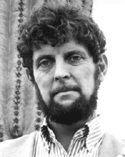
The Lava Lake Foundation for Science and Conservation together with The Nature Conservancy and Wood River Land Trust present: "Local Foods, Local Landscapes: Linking Food Systems and Land Conservation," an evening with Gary Paul Nabhan, PhD.
Join us for a lecture by Dr. Nabhan on Friday, October 6th, from 7:00 to 8:00 PM at the Liberty Theatre in Hailey. Dr. Nabhan will discuss the links between food production, local economies, and conservation in the West.
Tickets are $5.00 at the door. Gary Paul Nabhan is a writer, lecturer, and world-renowned conservation scientist.
He is Director of the Center for Sustainable Environments at Northern Arizona University, where his current work is the marketing of place-based heritage foods as a means to support land conservation in rural communities of the Intermountain West. Nabhan has received a MacArthur "Genius" award, a liftime achievement award from the Society of Conservation Biology, and a John Burroughs Medal for Nature Writing.
The Liberty Theatre is located at 110 North Main Street in Hailey. For more information, email Heather Kimmel or phone her at 208- 788-3947.
Wednesday, October 04, 2006
Nature Conservancy Destination: Southern Arizona
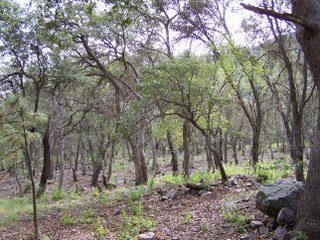 Last week, I had the opportunity to visit several Nature Conservancy projects in southern Arizona. On any travel, it pays to check out chapter web sites to see if you can include a trip to one of our preserves in your visit.
Last week, I had the opportunity to visit several Nature Conservancy projects in southern Arizona. On any travel, it pays to check out chapter web sites to see if you can include a trip to one of our preserves in your visit.Southern Arizona has some of the most well-known preserves in the country. Ramsey Canyon Preserve is located where the Sierra Madre of Mexico, the Rocky Mountains and the Sonoran and Chihuahan deserts come together. The mountains, which arise abruptly from the surrounding desert, creates habitat for a tremendous diversity of species.
The terrain here looks more like forest I saw in Australia than the saguaro-filled landscape near Tucson. Stunning rock formations can be seen from the hiking trails that wind through the preserve.
The preserve is best known as a destination for birders. As many as 14 species of hummingbirds can be found here, as well as tropical species like the elegant trogon. I arrived a bit too late for the hummingbird migration, but I did see plenty of beautiful lizards, the Ramsey Canyon leopard frog and a number of Coues deer:
 At other times of year, visitors may see javelina, coati, black bear and a tremendous variety of birds. The preserve includes several ponds, constructed to mimic wetlands that once were found in this valley, located along the stream. These ponds are part of a project to conserve Ramsey canyon leopard frog, a rare species found nowhere else on earth. These frogs can be easily seen during a visit.
At other times of year, visitors may see javelina, coati, black bear and a tremendous variety of birds. The preserve includes several ponds, constructed to mimic wetlands that once were found in this valley, located along the stream. These ponds are part of a project to conserve Ramsey canyon leopard frog, a rare species found nowhere else on earth. These frogs can be easily seen during a visit.The preserve includes a great interpretive facility and gift shop with books, birding supplies and Nature Conservancy clothing.
It is located about 1.5 hours from Tucson and makes a nice stop during a trip to see other popular tourist sites in the area, including Saguaro National Park, the Arizona-Sonora Desert Museum and Tombstone.
Visit a Nature Conservancy preserve, and see firsthand how your investment is paying off.